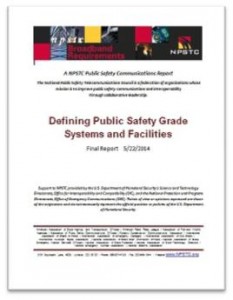NPSTC Broadband Working Group announces publication of Defining Public Safety Grade Systems and Facilities
 The National Public Safety Telecommunications Council (NPSTC) Broadband Working Group (BBWG) is proud to announce the publication of Defining Public Safety Grade Systems and Facilities. The definition is of critical importance to public safety agencies and to the First Responder Network Authority (FirstNet) which has been charged with building a nationwide public safety broadband network (NPSBN).
The National Public Safety Telecommunications Council (NPSTC) Broadband Working Group (BBWG) is proud to announce the publication of Defining Public Safety Grade Systems and Facilities. The definition is of critical importance to public safety agencies and to the First Responder Network Authority (FirstNet) which has been charged with building a nationwide public safety broadband network (NPSBN).
This report defines “Public Safety Grade” (PSG) communications and provides measurable characteristics which would differentiate a mission critical communications system from a standard or commercial grade network. The report covers environmental considerations, service level agreements, reliability and resiliency, coverage, push-to-talk, applications, site hardening, installation, and operations and maintenance.
“This is a huge milestone in our quest to develop requirements for FirstNet,” said Marilyn Ward, Executive Director, NPSTC. “Thanks to David Buchanan, Task Group Chair, and the numerous volunteers from public safety and industry.”
Reliability is achieved in public safety LMR systems through equipment redundancy and minimizing single points of failures. Resiliency is achieved through careful network design, taking into consideration a variety of local environmental factors and how events such as earthquakes, wildland fires, hurricanes, floods, lightning, ice, tornadoes, and even vermin can disrupt or damage the NPSBN network.
Hardening of sites to prevent failure is one of the most critical elements in the construction of a reliable and resilient communications system. This section covers the majority of all systems and infrastructure at a site, including power, security, site hardening, electronics, and other elements. This section was developed by the Association of Public Safety Communications Officials – International (APCO’s) Broadband Committee through a working group. APCO has expressed interest in the creation of an American National Standards Institute (ANSI) standard involving site hardening to provide a single source document for use by emergency responder agencies working with broadband or LMR systems.
The goal is for the NPSBN to be equivalent to public safety land mobile radio (LMR) systems that support law, fire, and emergency medical service (EMS) operations and are commonly referred to as “mission critical systems.” Design choices must support a greater overall network reliability and resiliency to network disruptions compared to commercial networks.
Communications are vital to both public safety field and command personnel during routine, local incidents and even more so during major incidents covering a larger area. Public safety voice LMR networks today are among the most reliable networks available in the United States. Today’s commercial wireless networks are not built to the same standard. The NPSBN must be constructed to meet as many of these PSG requirements as possible. And, since network and cell site sharing with commercial operators may be part of the NPSBN design, those commercial sites which also house NPSBN equipment must be upgraded to meet as many of these requirements as possible. The NPSBN must be relied upon and trusted by the public safety community. It must be a Public Safety Grade network, not a commercial “best effort” network. Emergency responders and their commanders depend upon communications systems to be fully functional at all times and under all circumstances. In order to be successfully adopted by the public safety community, the NPSBN cannot be anything less.

